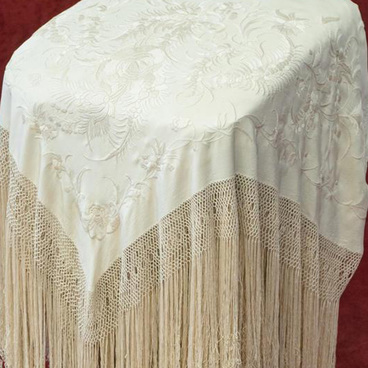Orlets is a small round rug, which was used in Orthodox services. It was laid under the bishop’s feet when he said prayers. As a rule, such a rag had an embroidered eagle soaring above the city. Orlets from the collection of the Tobolsk Historical and Architectural Museum-Reserve belonged to Holy Martyr Bishop of Tobolsk and Siberia Hermogenes (Dolganov), who, as the spiritual leader of the pre-revolutionary Black-Hundred movement, was sent to the Tobolsk cathedra. Apart from the single-headed eagle, the orlets has embroidered flowers gathered in a wreath and a monogram ‘E.G.’ (Bishop Hermogenes).
Bishop of Tobolsk and Siberia Hermogenes, whose secular name was Georgy Dolganov, was born in the family of a priest, graduated from secular university in Novorossiysk, but chose to serve God. At the Theological Academy, he took monastic tonsure. After the 1917 February coup, the bishop was appointed to the Tobolsk cathedra.
In Tobolsk, the bishop met the exiled imperial family, secretly sent them icons, prosphoras, prayers, blessings and maintained correspondence with them. Responding to the call of Patriarch Tikhon to defend the Church, Bishop Hermogenes, decided to hold a crucession in Tobolsk on Palm Sunday, the 15th of April. Shortly before, on the 12th of April, the entire imperial family was taken from Tobolsk to Yekaterinburg, and the next day the Bolsheviks intended to arrest Bishop Hermogenes. Near the wall of the Tobolsk Kremlin, the bishop blessed the Tsar’s family in prayer. In response to an inquiry by the local Bolshevik authority regarding the incident, Bishop Hermogenes answered: “… according to the Holy Scriptures, state law, church canons, as well as according to history, former kings, tsars and emperors who are out of the government of their country do not lose their rank as such or their respective titles, and therefore I did not see then anything reprehensible in the actions of the clergy of the Intercession Church and do not see it now”.
Soon he was arrested as a “Black-Hundreder and pogromist” and drowned in the Tobol River on the night from the 15th to the 16th June. Saint Hermogenes was canonized by the Russian Church Outside Russia in 1981, and in the Russian Federation at the jubilee Bishops’ Council in August 2000.
Bishop of Tobolsk and Siberia Hermogenes, whose secular name was Georgy Dolganov, was born in the family of a priest, graduated from secular university in Novorossiysk, but chose to serve God. At the Theological Academy, he took monastic tonsure. After the 1917 February coup, the bishop was appointed to the Tobolsk cathedra.
In Tobolsk, the bishop met the exiled imperial family, secretly sent them icons, prosphoras, prayers, blessings and maintained correspondence with them. Responding to the call of Patriarch Tikhon to defend the Church, Bishop Hermogenes, decided to hold a crucession in Tobolsk on Palm Sunday, the 15th of April. Shortly before, on the 12th of April, the entire imperial family was taken from Tobolsk to Yekaterinburg, and the next day the Bolsheviks intended to arrest Bishop Hermogenes. Near the wall of the Tobolsk Kremlin, the bishop blessed the Tsar’s family in prayer. In response to an inquiry by the local Bolshevik authority regarding the incident, Bishop Hermogenes answered: “… according to the Holy Scriptures, state law, church canons, as well as according to history, former kings, tsars and emperors who are out of the government of their country do not lose their rank as such or their respective titles, and therefore I did not see then anything reprehensible in the actions of the clergy of the Intercession Church and do not see it now”.
Soon he was arrested as a “Black-Hundreder and pogromist” and drowned in the Tobol River on the night from the 15th to the 16th June. Saint Hermogenes was canonized by the Russian Church Outside Russia in 1981, and in the Russian Federation at the jubilee Bishops’ Council in August 2000.

